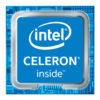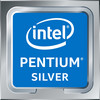Intel Celeron N5100 vs Intel Core i5-8365U vs Intel Pentium Silver N6000
Intel Celeron N5100
► remove from comparison
The Intel Celeron N5100 is a quad-core SoC of the Jasper Lake series that is primarily intended for inexpensive notebooks and was announced in early 2021. The four Tremont CPU cores clock between 1.1 and 2.8 GHz (single core Burst) and offer no HyperThreading (SMT). The N5100 uses 1.5 MB L2 and 4 MB L3 cache. The chip is manufactured in 10nm at Intel (most likely in the same process as Ice Lake).
Architecture
The processor architecture is called Tremont and a complete redesign compared to the old Golmont Plus cores in the predecessor. According to Intel, the single thread performance of a core could be improved by 30% on average (10 - 80% in all tests of SPECint and SPECfp).
Features
In addition to the quad-core CPU block, the SoC integrates a 24 EU Intel UHD Graphics GPU clocked from 350 - 800 MHz and a LPDDR4(x) dual channel memory controller (up to 16 GB and 2933 MHz). The chip now also partly integrates Wi-Fi 6 (Gig+), 8 PCIe 3.0 lanes, 14 USB 2.0/ 3.2 ports and two SATA 6.0 ports. The package got bigger and measures 35 x 24 mm (compared to 25 x 24 mm for the N5030 e.g.). The SoC is directly soldered to the mainboard (BGA) and can't be easily replaced.
Performance
While we have not tested a single system powered by the N5100 as of August 2023, it's safe to expect the chip to be 10% to 20% slower than the N6000, as far as multi-thread performance is concerned. In other words, this is a fairly slow processor that is unlikely to make anybody happy.
Power Consumption
Like most other N-class Intel processors, this Celeron has a 6 W default TDP (also known as the long-term power limit). This is rather low; a small metal plate is all it takes to dissipate heat generated by such a CPU.
The Celeron N5100 is manufactured on Intel's first-generation or second-generation [no exact data available] 10 nm process for average, as of early 2023, energy efficiency.
Intel Core i5-8365U
► remove from comparisonThe Intel Core i5-8365U is a power efficient quad-core SoC for notebooks and Ultrabooks based on the Whiskey Lake generation and was announced in April 2019 as part of two vPro capable CPUs of the WHL-U series. Compared to the similar named Kaby Lake-R processors (e.g. Core i5-8250U), the Whiskey Lake CPUs are now produced in a further improved 14nm process (14nm++) and offer higher clock speeds. The architecture and features are the same. The i5-8365U offers e.g. high Turbo clock speeds of 4.1 GHz (versus 3.4 GHz of the i5-8250U) for a single core. The integrated GPU is still named Intel UHD Graphics 620 and the dual-channel memory controller still supports the same RAM speeds as Kaby-Lake-R (DDR4-2400 / LPDDR3-2133). Thermal Velocity Boost is not supported (only in the Core i7-8565U).
Compared to the predecessor, the Core i5-8265U, the i5-8365U offers a 200 MHz higher Turbo Boost. As the i5-8365U first appeared in a Thinkpad, the CPU most likely supports vPRO for additional hardware management features.
The Whiskey Lake SoCs are used with a new PCH produced in 14nm that supports USB 3.1 Gen 2 (10 Gbps) and CNVi WiFi/BT parts.
Architecture
Intel basically uses the same micro architecture compared to Skylake and Kaby Lake, so the per-MHz performance does not differ. That means Whiskey Lake is a Kaby Lake chip manufactured in the improved 14nm++ process.
Performance
The performance of the i5-8365U depends on the cooling solution of the laptop and the defined TDP limits for short and long term performance. We already saw big differences for Kaby Lake-R (e.g., i7-8550U benchmarks), especially for long term (sustained) performance. Therefore, it will be interesting to see how the additionalTurbo clock speed can be made use of. Compared to the Core i5-8265U (see for benchmarks), the 200 MHz higher Turbo Boost should result in some gains in single core benchmarks.
Graphics
The integrated Intel UHD Graphics 620 (Intel Gen 9.5) is untouched from the 8th Gen Kaby Lake chips. With fast dual-channel memory it can reach the performance of a dedicated GeForce 920M.
Contrary to Skylake, Kaby Lake and Whiskey Lake now also supports H.265/HEVC Main 10 with a 10-bit color depth as well as Google's VP9 codec. The dual-core Kaby Lake processors announced in January should also support HDCP 2.2.
Power Consumption
The chip is manufactured in a further improved 14nm process with FinFET transistors (14nm++), the same as the 8th Gen Coffee Lake processors. Intel still specifies the TDP with 15 Watts, which is typical for ULV chips. Depending on the usage scenario, the TDP can vary between 7.5 (cTDP Down) and 25 Watts.
Intel Pentium Silver N6000
► remove from comparison
The Intel Pentium Silver N6000 is a quad-core SoC of the Jasper Lake series that is primarily intended for inexpensive notebooks and was announced in early 2021. The four Tremont CPU cores clock between 1.1 and 3.3 GHz (single core Burst) and offer no HyperThreading (SMT). The N6000 uses 1.5 MB L2 and 4 MB L3 cache. The chip is manufactured on the first-gen 10 nm Intel process, the same process as Ice Lake.
Architecture
The processor architecture is called Tremont and a complete redesign compared to the old Golmont Plus cores in the predecessor. According to Intel, the single thread performance of a core could be improved by 30% on average (10 - 80% in all tests of SPECint and SPECfp).
Features
In addition to the four CPU cores, the SoC integrates a 32 EU Intel UHD Graphics GPU clocked from 350 - 850 MHz and a dual-channel DDR4 / quad-channel LPDDR4x memory controller (up to 16 GB and 2933 MHz). The chip now also partly integrates Wi-Fi 6 (Gig+), 8 PCIe 3.0 lanes, 14 USB 2.0/ 3.2 ports and two SATA 6.0 ports. The package got bigger and measures 35 x 24 mm (compared to 25 x 24 mm for the N5030 e.g.). The SoC is directly soldered to the mainboard (BGA) and can't be easily replaced.
Performance
The average N6000 in our database proves to be an OK entry-level processor, as of late 2022, its multi-thread benchmark scores nearly matching those of the AMD Ryzen 3 3200U. Yes, the chip is a whole lot slower than the latest Ryzen 3 and Core i3 processors, but it will at least let you run your day-to-day apps without annoying slowdowns.
The Asus Vivobook 13 Slate is among the fastest systems built around the N6000 that we know of, thanks to the long-term CPU power limit of 10 W. It can be more than 20% faster in CPU-bound workloads than the slowest system featuring the same chip in our database, as of August 2023.
Power consumption
Like nearly all other N-class Intel processors, the Pentium N6000 has a default TDP of 6 W (also known as the long-term power limit). This is low and thus good enough for passively cooled tablets, laptops, mini-PCs.
The SoC is built with Intel's 2nd generation 10 nm process (not 10 nm SuperFin or Intel 7) for low, as of mid 2023, energy efficiency.
| Model | Intel Celeron N5100 | Intel Core i5-8365U | Intel Pentium Silver N6000 | ||||||||||||||||||||||||||||||||||||||||||||||||||||||||||||||||
| Series | Intel Jasper Lake | Intel Core i5 | Intel Jasper Lake | ||||||||||||||||||||||||||||||||||||||||||||||||||||||||||||||||
| Codename | Jasper Lake | Whiskey Lake-U | Jasper Lake | ||||||||||||||||||||||||||||||||||||||||||||||||||||||||||||||||
| Series: Jasper Lake Jasper Lake |
|
|
| ||||||||||||||||||||||||||||||||||||||||||||||||||||||||||||||||
| Clock | 1100 - 2800 MHz | 1600 - 4100 MHz | 1100 - 3300 MHz | ||||||||||||||||||||||||||||||||||||||||||||||||||||||||||||||||
| L2 Cache | 1.5 MB | 1 MB | 1.5 MB | ||||||||||||||||||||||||||||||||||||||||||||||||||||||||||||||||
| L3 Cache | 4 MB | 6 MB | 4 MB | ||||||||||||||||||||||||||||||||||||||||||||||||||||||||||||||||
| Cores / Threads | 4 / 4 | 4 / 8 | 4 / 4 | ||||||||||||||||||||||||||||||||||||||||||||||||||||||||||||||||
| TDP | 6 Watt | 15 Watt | 6 Watt | ||||||||||||||||||||||||||||||||||||||||||||||||||||||||||||||||
| Technology | 10 nm | 14 nm | 10 nm | ||||||||||||||||||||||||||||||||||||||||||||||||||||||||||||||||
| max. Temp. | 105 °C | 100 °C | 105 °C | ||||||||||||||||||||||||||||||||||||||||||||||||||||||||||||||||
| Socket | BGA1338 | BGA1528 | BGA1338 | ||||||||||||||||||||||||||||||||||||||||||||||||||||||||||||||||
| Features | DDR4-2933/LPDDR4x-2933 RAM, PCIe 3, GNA, MMX, SSE, SSE2, SSE3, SSSE3, SSE4.1, SSE4.2, VMX, SMEP, SMAP, EIST, TM1, TM2, Turbo, AES-NI, RDRAND, RDSEED, SHA | Dual-Channel DDR4 Memory Controller, HyperThreading, AVX, AVX2, Quick Sync, Virtualization, AES-NI | DDR4-2933/LPDDR4x-2933 RAM, PCIe 3 x 8, GNA, MMX, SSE, SSE2, SSE3, SSSE3, SSE4.1, SSE4.2, SMEP, SMAP, EIST, TM1, TM2, Turbo, SST, AES-NI, RDRAND, RDSEED, SHA | ||||||||||||||||||||||||||||||||||||||||||||||||||||||||||||||||
| iGPU | Intel UHD Graphics (Jasper Lake 24 EU) (350 - 800 MHz) | Intel UHD Graphics 620 (300 - 1100 MHz) | Intel UHD Graphics (Jasper Lake 32 EU) (350 - 850 MHz) | ||||||||||||||||||||||||||||||||||||||||||||||||||||||||||||||||
| Architecture | x86 | x86 | x86 | ||||||||||||||||||||||||||||||||||||||||||||||||||||||||||||||||
| Announced | |||||||||||||||||||||||||||||||||||||||||||||||||||||||||||||||||||
| Manufacturer | ark.intel.com | ark.intel.com | ark.intel.com | ||||||||||||||||||||||||||||||||||||||||||||||||||||||||||||||||
| L1 Cache | 256 KB |


 Deutsch
Deutsch English
English Español
Español Français
Français Italiano
Italiano Nederlands
Nederlands Polski
Polski Português
Português Русский
Русский Türkçe
Türkçe Svenska
Svenska Chinese
Chinese Magyar
Magyar
